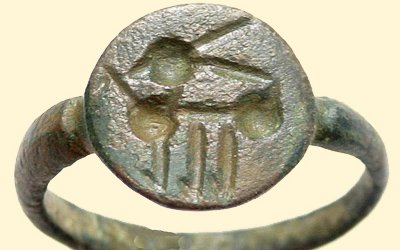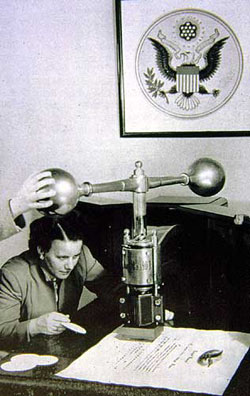|
Main Pages
Front Page
Overview
Seal FAQs
Design Process
1st Committee
2nd Committee
3rd Committee
Final Design
Description
Explanation
Latin Mottoes
E Pluribus Unum
Annuit Coeptis
Novus Ordo Seclorum
Symbols (front)
Bald Eagle
Shield
Olive Branch
Arrows
Stars
Rays of Light
Cloud
Symbols (back)
Pyramid
Eye
MDCCLXXVI
Great Seals
Official Dies
First Engravings
First Painting
1792 Medal
Indian Medals
1882 Medal
One-Dollar Bill
Myths
Eagle Side
Pyramid Side
Themes
Unity
Peace
Liberty
Thirteen
Related
Wild Turkey
President's Seal
Sightings
Resources
|

Good 2-minute video
|
What is a Seal?
The words "seal" and "signature" both derive from signum – the Latin word for "sign." A seal is a pictorial sign that signifies and identifies an individual or group. (A "signet" ring worn on the finger has a small seal or one's initials.)

Seals have been used since the dawn of civilization, when bundles of trade goods were sealed with tags that carried an impression of the owner's mark. For the past 6,000 years, cultures old and new have used seals to indicate ownership, for security reasons, and to formalize contracts and agreements.
|
Great Seal FAQs
What is the Great Seal?
A "great" seal is the principal seal of a nation. Other branches of government – as well as corporations and families – also have seals.
The design of the Great Seal is defined by its written description approved by Congress on June 20, 1782. Dies and illustrations will therefore vary somewhat in appearance, because each is an interpretation of this official description written in heraldic terms.
The Great Seal is also the actual engraved metal die that impresses the design onto a document, as well as the impression made by the die (and the substance bearing the impression). The die currently in use by the U.S. State Department is the seventh die used since 1782.
Why Does the Great Seal Have Two Sides?
A reverse side was designed because in the 18th century, pendant seals were used. These were in the form of a disk of wax attached to the document by ribbons or cords. This disk had two sides, thus the need for a reverse side of the Great Seal. But a die for the reverse was never cut.
 Where is the Great Seal?
Where is the Great Seal?
In the State Department, the term "Great Seal" also includes the counter-die, the press, and the mahogany cabinet in which it is housed. These are located in the Exhibit Hall of the Department in Washington DC, inside a glass enclosure that's kept locked at all times – even during the sealing of a document.
How are Documents Sealed?
A paper wafer is first glued to the document. Then the operator of the Great Seal press inserts the document to be sealed between the Great Seal die and its counter-die, with the wafer centered on each. The press creates the image of the obverse side of the Great Seal in relief on the wafer.
**
Video National Museum of American Diplomacy
https://diplomacy.state.gov/explore-online-exhibits/the-great-seal/
Watch the Great Seal in action:

A Taste of History (PBS 2016) visits the State Department,
where the Great Seal is impressed on a document
(about 10 minutes into the half-hour video).
What Kinds of Documents Qualify for the Great Seal?
The Secretary of State normally affixes the Great Seal to documents that serve a purpose in international affairs. After they have been signed by the President of the United States, the following types of documents qualify for the Great Seal:
- Proclamations of treaties and other international agreements
- Instruments of ratification or acceptance of, or adherence to, treaties and other international agreements
- Appointment commissions of Ambassadors and Foreign Service officers
- Assignment commissions for consular officers
- Letters of credence and recall for Ambassadors, and letters of credence for special representatives on ceremonial diplomatic missions
What is the "Coat of Arms" of the United States?
A coat of arms is the official mark and emblem of a sovereign nation's authority. The coat of arms of the United States is the design or device found on the obverse side of the Great Seal. In other words, it is the eagle with its shield, arrows, olive branch, and scroll – as well as the stars, glory, and cloud that form the "crest" above the eagle's head.
|
"Whoever knowingly displays any printed or other likeness of the great seal of the United States, or of the seals of the President or the Vice President of the United States, or any facsimile thereof, in, or in connection with, any advertisement, poster, circular, book, pamphlet, or other publication, public meeting, play, motion picture, telecast, or other production, or on any building, monument, or stationery, for the purpose of conveying, or in a manner reasonably calculated to convey, a false impression of sponsorship or approval by the Government of the United States or by any department, agency, or instrumentality thereof, shall be fined not more than $250 or imprisoned not more than six months, or both."
– U.S. Code, Title 18, Part I, Chapter 33, Section 713(a)
|
|

